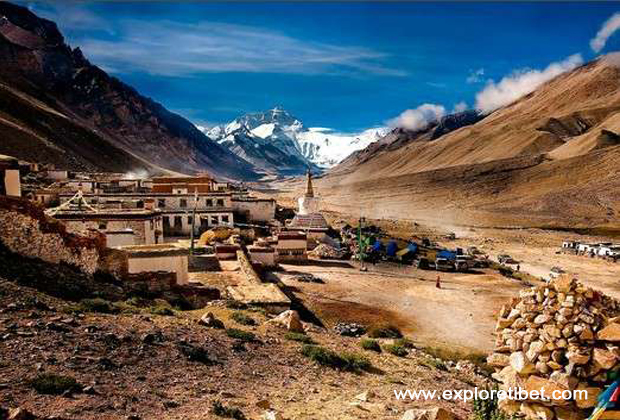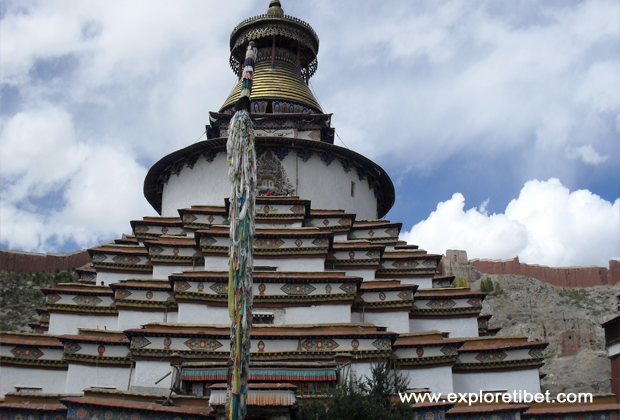The Highest Monasteries in Tibet – Why Rongbuk is not the Highest Monastery in the World
Tibet is renowned as the highest plateau on the planet, and with this being a devoutly Buddhist land, it should come as no surprise that this vast plateau, which is also home to the highest mountain on the planet, also has the highest Buddhist monastery in the world. However, many people are confused as to which is exactly the highest Buddhist monastery in the world. Most articles and even Wikipedia have got it completely wrong in favor of a popular tourist spot instead of the real highest monastery on the planet.
Thirteen Pagoda – 5,860m
Technically, this is not actually a manned monastery, and is merely a pagoda at the highest point of the Inner Kora Route around Mount Kailash in western Tibet’s Ngari Prefecture. However, it is actually the highest Buddhist construction in the world, even if it is not the highest monastery.
Technically the highest monastery in Tibet, Drirapuk Monastery is located to the north of Mount Kailash on the famous Kailash Kora trek. At an altitude of 5,210 meters above sea level, Drirapuk Monastery is often wrongly listed as having an elevation of just 4,950 meters. A beautiful monastery that has a huge collection of murals, scriptures, historical relics, and Buddha statues, the monastery is an important stop on the ritual kora route around Mount Kailash for pilgrims, and provides simple food and accommodation for travelers, both local pilgrims and international tourists.

Drirapak Monastery
Gyangdrak Monastery – 5,075m
The second highest monastery in the world is also in Tibet, and sits at an altitude of 5,075 meters above sea level. The first monastery to be constructed on Mount Kailash, its construction began with a simple pagoda in the 13th century, and was expanded over the next 100 years to its current state. The oldest and most significant monastery on both the outer and inner Kailash Koras, the monastery features some very distinct architecture that is a mix of ancient Tibetan and Nepali. The monastery contains several sacred statues, as well as several relics and ancient murals, and on the hillside next to the monastery sit more than 50 small chortens.
Selung Temple – 5,020m
The first monastery you will reach on the Kailash Inner Kora route, Selung Temple is the third highest monastery in the world, at an elevation of 5,020 meters above sea level. Unlike the Gyangzha Monastery, Selung does not have the religious and historical significance aside from being a topping point on the Inner Kora. Built in the latter part of the 14th century, it was originally a meditation retreat for the most devout of monks visiting Mount Kailash. Much of the monastery now lies in ruins, with only a few small outhouses still in one piece, and the monastery is now only used as a meditation place for pilgrims on the Inner Kora.
For many people around the world and on Tibet Tours, the highest monastery in the world is the Rongbuk Monastery, at the foot of the Rongbuk Glacier just to the north of Mount Everest. Located just a short distance from the Mount Everest Base Camp in Tibet, this relatively-new monastery, which was completed in 1902, is listed in Wikipedia and in many articles on Tibet as the highest monastery in the world, at an elevation of 4,980 meters (16,340 ft.) above sea level. However, Rongbuk is actually the fourth highest monastery in the world. Yet even the altitude listed is wrong. The monastery main hall is actually at a ground altitude of 5,019 meters (16,466 ft.), almost 40 meters higher than listed.

Rongbuk Monastery
Chuku Monastery – 4,875m
The fifth highest monastery in Tibet, Chuku Monastery lies at an altitude of 4,875 meters, and stands on the western banks of the Lha Chu, the river that flows down the valley from close by Drirapuk Monastery. Only around 2km from Tarboche, the location of the famous flagpole that is strung with hundreds of prayer flags, the monastery was built in the 13th century by the Drigung Kagyu Lineage, founded by Drigungpa Jigten Sumgon. The monastery has a huge number of relics, including a conch shell, teapot, and statue that cursed the thieves that attempted to steal them from the monastery. The stone statue of Buddha Opame and the silver-embossed conch shell and teapots are the most popular artifacts in the monastery.
Dzultripuk Monastery – 4,790m
Lying on the eastern side of Mount Kailash at an altitude of 4,790 meters, Dzultripuk Monastery is famous for being the second stopping point for pilgrims and tourists trekking around the Mount Kailash Outer Kora. Lying just 11 kilometers from the village of Darchen, the start and finish of the kora trek, this monastery also holds less significance than Drirapuk, and is mainly used as a stopping point for pilgrims and tourists. However, the location of the monastery in the lush valley does give a feeling of calm and serenity, and lies close to the Mani Wall along the final leg of the trek. It is also renowned among tourists as having the best accommodation on the trek.
Located in Gyantse County of Lhasa, around 97 kilometers to the north of the Tibetan capital, Ralung Monastery is one of the most sacred places in Tibet. The monastery is the place where the Drukpa School of Tibetan Buddhism – known as the red-hat monks – originated, and was founded in the 12th century by the first Gyalwang Drukpa, Tsangpa Gyare, who was a disciple of Lingje Repa, the founder of the Drukpa Lineage. Lying at an altitude of 4,774 meters, the monastery is surrounded by the towering peaks of Gyetong Soksum (6,244m), Jangzang Lhamo (6,324m), and Nojin Gangzang (7,191m). The monastery was also the home of the first Zhabdrung Rinpoche of Bhutan, Ngawang Namgyal, who fled Tibet in 1616 and unified the warring tribes in the valleys of what is now the Kingdom of Bhutan.
Gyangste Kumbum Stupa or Palkor Choede Monastery – 4,552m
Also known as the Pelkor Chode Monastery, Palcho Monastery lies in the town of Gyangtse, in Gyantse County of Shigatse Prefecture. Sitting at 4,552 meters above sea level, the monastery is renowned for being the only monastery in Tibet that houses three separate schools of Tibetan Buddhism – the Sakya Sect, the Kadam Sect, and the Gelug Sect. The earliest records of the monastery date back to around the 9th century, and is believed to have been founded by the son of the Tibetan king Langdharma, Pelkhor-tsen, after whom the monastery was named. The monastery is also the location of the famous Kumbum Stupa, a 32-meter high stupa that is the only one of its kind in Tibet.

Gyangtse Palkor Choede
In the nutshell, Tibet is a host of many high monasteries with its unique location on this planet and had preserved the traditional Tibetan Buddhism for many centuries which had made Tibet special spiritual destination for many tourists in the past few decades.
